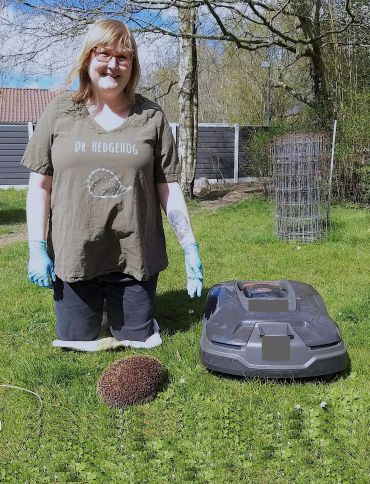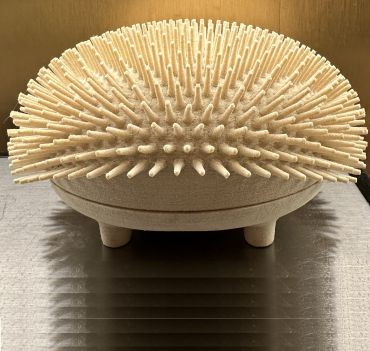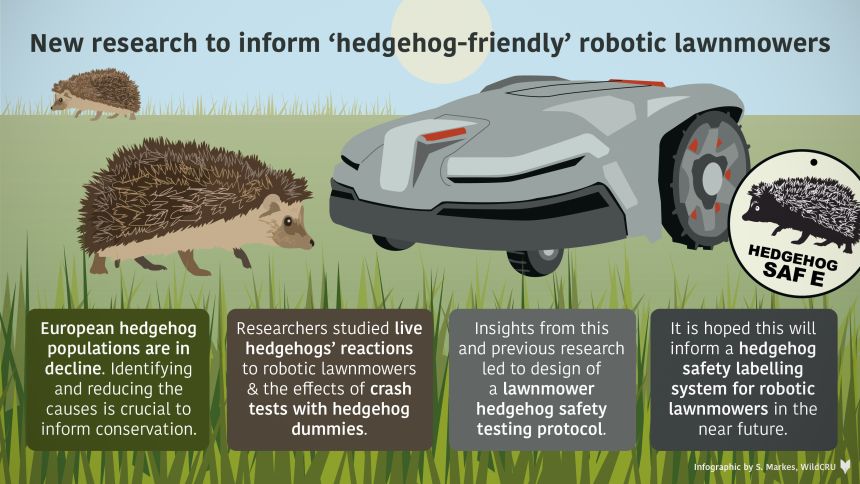
Dr Sophie Lund Rasmussen. Image credit: Dorthe Madsen.
Lead researcher Dr Sophie Lund Rasmussen (University of Oxford), also known as ‘Dr Hedgehog’, said: ‘There is an urgent need to identify and phase out models of robotic lawnmowers that pose a threat to hedgehogs. Our new standardised safety test will greatly aid hedgehog conservation, by enabling manufacturers of robotic lawnmowers to ensure their models are “hedgehog friendly” before they are put on the market.’
Dr Rasmussen was inspired to develop the test after carrying out collision tests between robotic lawnmowers and dead hedgehogs. The dead hedgehogs had been collected from hedgehog rehabilitation centres, and had been too injured or unwell to be saved.
Dr Rasmussen said: ‘All the robotic lawn mowers I tested had to physically touch the hedgehog in order to detect it, and some did not even detect the dead hedgehog. In mild cases, the robotic mower would lightly nudge the hedgehog then change direction, but in the worst-case scenario, the machine ran straight over it with the blades still running, causing extensive damage to the hedgehog carcass.’
The new safety test uses specially designed hedgehog ‘crash test dummies’ to find out whether a robotic lawnmower would be capable of avoiding a real hedgehog, and if not, how much damage it would cause in a collision.

One of the 3D printed hedgehog crash test dummies developed by the researchers. Image credit: Sophie Lund Rasmussen.
Overall, the hedgehogs showed three distinct responses: running away from the mower; standing rigidly in front of it partially curled up; or sniffing the lawnmower inquisitively. Generally, younger hedgehogs were more bold than adult hedgehogs.
Dr Rasmussen said: ‘Each hedgehog was tested twice and, interestingly, they tended to act more shyly on their second encounter. This is hugely important, since it suggests that hedgehogs may learn from their first encounter with a robotic lawnmower. Potentially, if a hedgehog survives its first encounter with a robotic lawnmower, it is less likely to be injured in the future because this may cause it to avoid them. So, the more hedgehog friendly mowers out there, the more chance there is that the first mower a hedgehog meets is a hedgehog friendly one. If these hedgehogs meet a mower again later in their lives, they will then likely be more cautious.’
Using the findings, the researchers identified the key positions that a crash test dummy should be placed in, to simulate the main responses of a live hedgehog during a lawnmower safety test. The dummy was designed based on the initial collision tests, and is made from a soft rubbery plastic that closely mimics the body composition of a real hedgehog.

Infographic summarising the research findings, designed by Sarah Markes, WildCRU.
The researchers intend to make the crash test dummy design publicly available for 3D printing, so that robotic lawn mower companies can readily access it. The project is supported by industry partners STIHL and Husqvarna, who intend to use these findings as part of their efforts to develop hedgehog friendly robotic lawnmowers.
Ultimately, the researchers hope that the hedgehog safety test using the dummies will become integrated into the official testing protocols approving the robotic lawnmowers for sale on the European market. This could enable a certification scheme that will allow consumers to choose ‘hedgehog-friendly’ models.
We are pleased to have been involved in funding this important piece of research. The population decline of hedgehogs is alarming and unsustainable so it is crucial to find out which potential dangers are actually causing problems, and which are not. Hopefully, the results of this work will stop or drastically reduce the risk of robotic lawnmowers causing harm to hedgehogs.
Fay Vass, Chief Executive, British Hedgehog Preservation Society
Dr Rasmussen added: ‘A key first step is to improve the sensors, so that they detect the hedgehogs and avoid them. Developing additional technologies such as camera recognition could eventually allow the robotic lawn mowers to detect hedgehogs at a distance and change direction before they get close. It is also important that the blades of the mowers are pivoting, so that they fold away under a protective surface when hitting something harder than grass.’
Phasing out robotic lawnmowers that are a threat to hedgehogs could have a significant impact on the survival of this iconic species. In the meantime, owners of robotic lawnmowers can help protect hedgehogs by checking for any hedgehogs on the lawn before turning on the mowers and only running these machines during daylight hours, since hedgehogs are predominantly nocturnal.
Co-author of the study Dr Anne Berger (Leibniz Institute for Zoo and Wildlife Research, Germany), who has researched the frequency of hedgehog injuries from robotic lawnmowers in Germany, said: ‘Cut injuries from robotic lawnmowers are placing an enormous burden on many hedgehog care centres and using up important resources, as these injuries often require above-average care and treatment. Moreover, the majority of hedgehogs with cut injuries are found days or weeks after the accident happened and therefore have to endure considerable suffering, pain and harm until they are found. The development of “hedgehog friendly” models could therefore help prevent a considerable amount of animal suffering.’
The results of this work have been published in the journal Animals:
This research was funded by Husqvarna, STIHL, the British Hedgehog Preservation Society, and Carlsberg Foundation.














